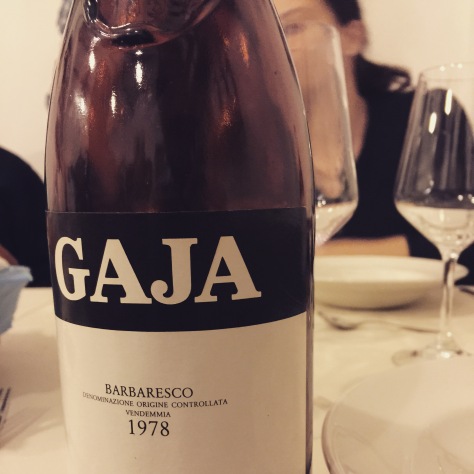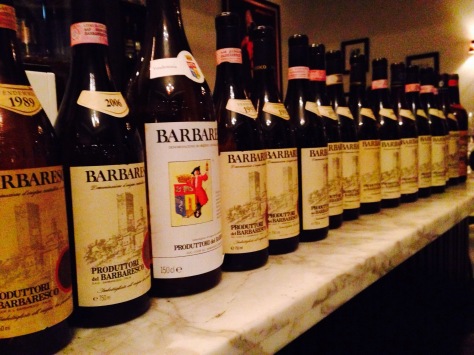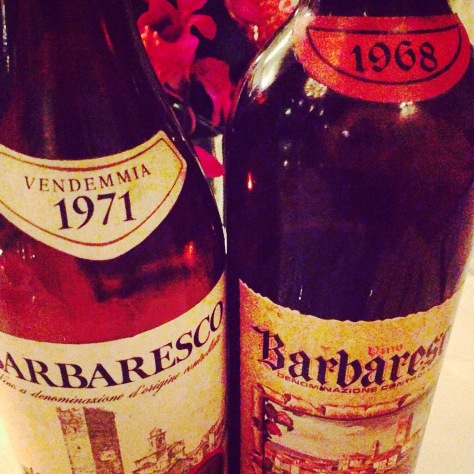
Last Thursday a group of Italian wine lovers headed to Scopri to indulge in the wines of Angelo Gaja and Bruno Giacosa. The aim was to present wines that illustrated the amazing heights both Angelo Gaja and Bruno Giacosa could hit at their peak with Nebbiolo, and mainly Nebbiolo grown in the Barbaresco region of the Langhe. Today both men have plots in both Barbaresco and Barolo so there was a couple of Barolo’s thrown in for good measure to show that both men are equally adept to both Barbaresco and Barolo.
Apart from three wines (two Giacosa’a and one Gaja) being corked on the night (more on that on my next post) the night was a big success and showed that these wines are truly world class and when on song, as good as any wine produced in the world today.
Below are notes from Antonio Galloni and Robert Parker from the Wine Advocate just to give you some background information plus my brief notes (in italic) on each wine as well.

Strikingly profound and built to live for decades, Gaja’s wines display opulence and elegance unmatched elsewhere in Italy. These wines, while harnessing modern technology, have a long-established track record, ensuring they will perform well both in the glass and on the auction block. For any collector considering Italian wines, Gaja should be the first name on the list.

Bruno Giacosa, a man of few words but eloquent talent, practices an extremely simple philosophy based on the respect of traditions both in the vineyard and in the cellar. Giacosa brings out a richness of flavor and an intensity of character to produce wines of meditation. In addition to Bartolo Mascarello, and Giacomo Conterno, the Giacosa estate is the most respected producer of traditional style Barolo.
Bruno Giacosa Santo Stefano Barbaresco Riserva 1988
The 1988 is the most advanced of these Santo Stefanos. It is fully mature, with notes of leather, tobacco, beef bouillon, prunes and spices on a medium-bodied frame with soft tannins and excellent length. There appears to be little upside in cellaring bottles any further and I would choose to drink my remaining bottles within the next few years. Antonio Galloni In the Cellar Apr 2007
Rich and robust with fantastic length and breadth. It is slowly on the downhill slide and would have been a truly amazing wine six or seven years ago.
Bruno Giacosa Barbaresco 1989
Bruno Giacosa’s wines are well represented in my personal cellar, which was the source for the vast majority of these bottles. I have had the good fortune to taste all of Giacosa’s 1989s and 1990s from multiple sources over the last year, and therefore can report that these notes are representative of what readers can expect from well-stored bottles. I consider 1989 and 1990 – along with 1978, 1982, 1996, 2001, 2004 and 2007 – to be among Giacosa’s finest vintages. Antonio Galloni Wine Advocate #187 Feb 2010
Mildly corked and if this was a Friday night at home, I doubt the bottle would have gone down the sink. However, underneath the taint, there was some absolutely amazing fruit and tannins. If this bottle was sound, I would think it would have gone close to wine of the night.
Bruno Giacosa Gallina di Neive Barbaresco 1990
The 1990 Barbareso Gallina is simply awesome. The wine boasts a seamless core of rich red fruits in a soft, generous style. This opulent Barbaresco possesses impeccable balance and tons of class. Floral notes intermingled with bright red fruits provide lift on the finish, adding lovely balance to the dense fruit. This is the most approachable of Giacosa’s 1990s but has plenty of stuffing to last another twenty years. The 1978 is still going strong. Anticipated maturity: 2010-2025. 94 points Antonio Galloni Wine Advocate #187 Feb 2010
Corked. Again enough taint to mask the sheer quality of the wine.

Angelo Gaja Cerequio Conteisa Barolo 1990 (notes below courtesy of The Iron Chevsky Wine Blog)
In a recent Gaja and Burgers post, I talked about Gaja Gromis Barolo 2000, and raised a question about the connection of Gaja Gromis and Gaja Dagromis. For the wine geeks such as myself this connection needed to be explored. And since there was little-to-nothing on the internet regarding this topic, I emailed Gaia Gaja, the daughter of Angelo Gaja. She and I had recently met at a dinner at Donato Enoteca.
Dear Gaia,
…
I need a clarification. From my research on the internet, it is not clear what is the relationship between the Gromis Barolo, the Gromis Conteisa Cerequio Barolo, Conteisa Langhe and the Dagromis Barolo, and when some of the labels changed.
Dutifully Gaia responded. Here is the fascinating Gaja trivia that I learned.
In 1995 Gaja bought a propriety in La Morra. The property is 10 hectares, almost all included in the Cerequio vineyard. The winery (an obsolete building which they do not use) had a stock of older vintages. It took them a bit of time to understand what they had.
The propriety was named Gromis. The stock that was in the cellar was inspected, some vintages have not been sold because they did not like the quality, but some other vintages were very good (1970, 1982, 1989, etc) so Gaja released them with the label Barolo Gromis.
CONTESIA CEREQUIO BAROLO was the label Gaja devoted for the best Cerequio parcells (some vintages were already in the barrels at the moment of the acquisition, for example 1991 or 1993). So for those wines they took care of the last part of the ageing.
In 1996 Gaja decided to devote 4 hectars in the heart of Cerequio cru for the production of Gaja Conteisa Langhe Nebbiolo DOC which (like all of Gaja’s single vineyards …Costa Russi, Sori San Lorenzo, Sori Tildin and Sperss) is a blend of Nebbiolo and Barbera, in this case 92% Nebbiolo and 8% Barbera.
Stunning, ripe fruit that is perfectly balanced and with at least another decade in front of it. Fantastic effort.

Angelo Gaja Barbaresco 1995
1995 tends to be a good rather than great vintage in Piedmont, but Gaja’s sensational 1995s are among the stars of the vintage. This wine possesses extremely saturated dark ruby/purple colors, almost atypical for Nebbiolo. The 1995 Barbaresco offers a superb nose of licorice, cherry fruit, strawberries, flowers, and toasty scents. Ripe, dense, and lush, with an alluring, sexy personality, it is one of the more forward, generic Barbarescos Gaja has produced. Anticipated maturity: now-2011. Importer: Vinifera Imports, Ronkonkoma, NY; tel. (516) 467-5907 90 points Robert Parker, Wine Advocate #124 Aug 1999
Would you believe it, corked!!
Angelo Gaja Barbaresco 1996
The 1996 Barbaresco exhibits a dense ruby color as well as a forward nose of cherry liqueur, earth, truffle, mineral, and spicy scents. Rich, full-bodied, and seductive, with its moderate tannin largely concealed by the wine’s wealth of fruit and extract, this gorgeously pure offering gets my nod as the finest Barbaresco produced by Gaja since 1990. Anticipated maturity: 2002-2016. As I reported in issue #124 (8-27-99), 1996 is a spectacular vintage for Angelo Gaja. 90 points Robert Parker Wine Advocate #130 Aug 2000
Looking amazing, great length and depth of fruit. This is Angelo Gaja on top of his game. Only criticism is that the oak still sticks out a touch on the front palate, but I expect this to disappear with another decade of age.
Angelo Gaja Barbaresco 1997
Gaja’s 1997 Barbaresco is undoubtedly the finest he has yet made. An exquisite effort, it boasts a dense ruby/purple color in addition to an extraordinary nose of black cherry liqueur, smoke, licorice, mineral, and floral aromas. The wine is full-bodied, opulent, and loaded with fruit. Despite its precocious nature, there is abundant tannin, and thus 3-4 years of cellaring is required. It should age effortlessly for 25 years.
A genius for sure, Angelo Gaja can not be faulted for what he puts in the bottle. This work of art is worth every cent it will fetch. Robert Parker 94 points, Wine Advocate #135 Jun 2001
Balanced, lovely wine: in the groove and looking good. More complete wine than the 96 Gaja but it will be interesting to see which is better in the long run.
Angelo Gaja Sori San Lorenzo 2004
The 2004 Sori San Lorenzo is a drop-dead gorgeous wine. It presents awesome balance, especially in the way it marries power with elegance. This is a remarkably refined and understated Sori San Lorenzo, with never-ending layers of dark raspberries, licorice, grilled herbs and tar that flow from its sumptuous frame. A dark, brooding beauty, it will require several additional years of bottle at a minimum, but those with the patience to wait will be amply rewarded. In most vintages I prefer the Sori Tildin, but in 2004 Sori San Lorenzo has a very slight edge over its sibling. It may very well be the finest Sori San Lorenzo since the legendary 1971. Anticipated maturity: 2014-2029. 98 points Antonio Galloni Wine Advocate #173 Oct 2007
The Barbera component is really sticking out in this wine. Darker in colour and more sweeter palate. An awesome wine and maybe an indication why Barbera has traditionally been added in Nebbiolo.
Angelo Gaja Barbaresco 2006
The 2006 Barbaresco reveals terrific concentration, depth and purity. This is a remarkably soft, harmonious Barbaresco from Angelo Gaja with pretty notes of raspberries, crushed flowers and spices. The wine turns more powerful in the glass, as it gains additional richness, volume and depth, all of which carry through to the polished finish. The wine’s balance is impeccable, and this is easily is one the more harmonious, complete wines of the vintage. Anticipated maturity: 2016-2026. 93 points Antonio Galloni Wine Advocate # 185 Oct 2009
Awesome. So traditional almost the most pure expression of Nebbiolo on the night. Fragrant, savoury, perfumed and in the groove. This is going to live for a very long time.
Bruno Giacosa Falleto Barbaresco 1997
Giacosa’s 1997 Barolo Falletto de Serralunga is an exquisite Barolo offering superb notes of tar, earth, truffles, licorice, minerals, and cherry/raspberry fruit. There is plenty of acidity as well as high tannin, but concentrated, chewy flavors. The wine is tight, dense, impressive, and surprisingly structured for a 1997. Anticipated maturity: 2003-2025. 93 points Robert Parker Wine Advocate #135 Jun 2001
In it’s prime and a lovely wine. Still looking pristine and highlights just what an amazing man Bruno Giacosa is, whether it is Barolo or Barbaresco.




















